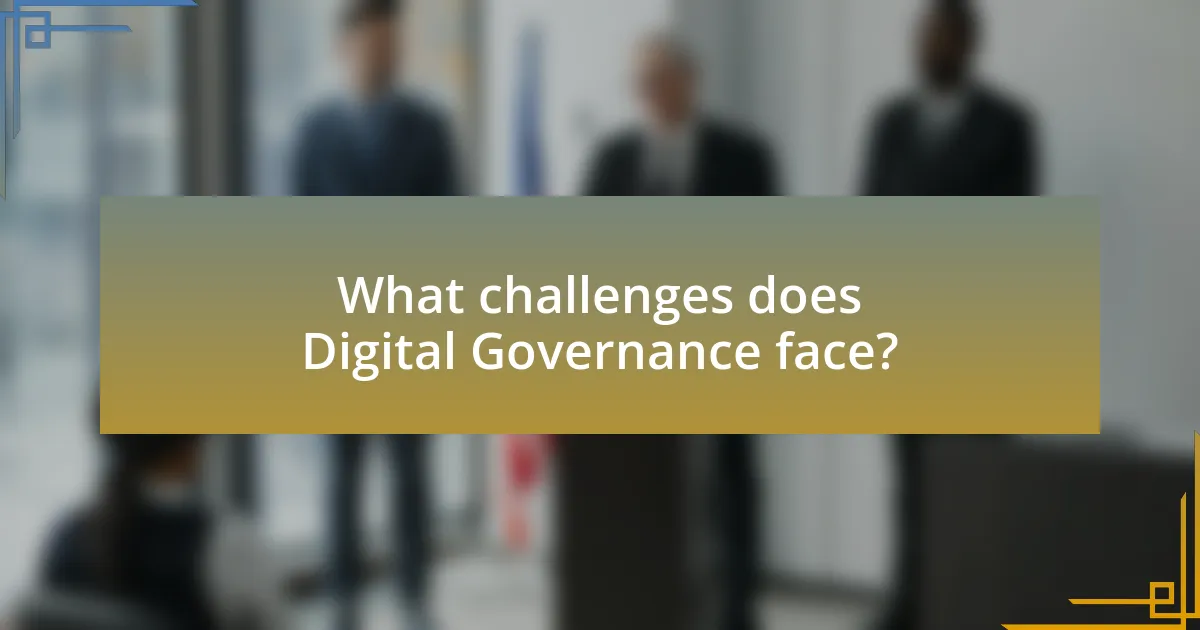Digital governance is a framework that organizations utilize to manage digital resources, ensuring accountability, transparency, and compliance. This article explores the evolution of digital governance, highlighting its differences from traditional governance, key components, and the influence of technology on its principles. It examines the objectives of digital governance, including enhancing transparency and citizen engagement, while also addressing the challenges such as data privacy concerns and cybersecurity threats. Furthermore, the article discusses the economic benefits, opportunities for innovation, and the future outlook for digital governance, emphasizing the role of emerging technologies like artificial intelligence and blockchain in shaping effective governance models.

What is Digital Governance?
Digital governance refers to the framework and processes that organizations use to manage digital resources, ensuring accountability, transparency, and compliance in the digital environment. This governance encompasses policies, standards, and practices that guide the use of technology and data within an organization, aligning digital initiatives with overall strategic goals. For instance, the implementation of digital governance frameworks can lead to improved data management and enhanced decision-making, as evidenced by studies showing that organizations with strong digital governance practices experience higher levels of operational efficiency and risk management.
How does Digital Governance differ from traditional governance?
Digital governance differs from traditional governance primarily in its reliance on digital technologies to enhance transparency, efficiency, and citizen engagement. Traditional governance often involves bureaucratic processes and face-to-face interactions, whereas digital governance utilizes online platforms and data analytics to streamline operations and improve service delivery. For instance, a study by the United Nations E-Government Survey 2020 highlights that countries implementing digital governance frameworks have seen increased public participation and improved access to government services, demonstrating the effectiveness of technology in modern governance.
What are the key components of Digital Governance?
The key components of Digital Governance include policy frameworks, technology infrastructure, data management, stakeholder engagement, and compliance mechanisms. Policy frameworks establish guidelines for digital initiatives, ensuring alignment with organizational goals and regulatory requirements. Technology infrastructure encompasses the systems and tools necessary for implementing digital solutions, facilitating efficient operations. Data management focuses on the collection, storage, and analysis of data, which is crucial for informed decision-making. Stakeholder engagement involves collaboration with various parties, including citizens, businesses, and government entities, to enhance transparency and accountability. Compliance mechanisms ensure adherence to legal and ethical standards, safeguarding against risks associated with digital transformation. These components collectively contribute to effective Digital Governance, enabling organizations to navigate the complexities of the digital landscape.
How does technology influence the principles of Digital Governance?
Technology significantly influences the principles of Digital Governance by enhancing transparency, accountability, and citizen engagement. For instance, the use of blockchain technology ensures secure and transparent record-keeping, which fosters trust in governmental processes. Additionally, data analytics tools enable governments to analyze citizen feedback and service usage, leading to more responsive and accountable governance. According to a report by the United Nations, 70% of countries are leveraging digital technologies to improve public service delivery, demonstrating the widespread impact of technology on governance principles.
What are the main objectives of Digital Governance?
The main objectives of Digital Governance are to enhance transparency, improve service delivery, ensure citizen engagement, and promote accountability in public administration. Transparency is achieved through open data initiatives that allow citizens to access government information, fostering trust. Improved service delivery focuses on utilizing technology to streamline processes and provide efficient public services, as seen in e-governance platforms. Citizen engagement is prioritized by incorporating feedback mechanisms and participatory decision-making, which empower individuals to influence policies. Lastly, accountability is reinforced through digital tools that track government performance and expenditures, ensuring that public officials are answerable to the citizens they serve.
How does Digital Governance enhance transparency and accountability?
Digital Governance enhances transparency and accountability by utilizing technology to streamline information sharing and improve public access to government data. This approach allows citizens to easily access information about government operations, decisions, and expenditures, fostering an environment where officials are held accountable for their actions. For instance, platforms that publish real-time data on government spending enable citizens to track how public funds are utilized, thereby reducing opportunities for corruption. Additionally, digital tools such as e-participation and online feedback mechanisms empower citizens to engage with government processes, ensuring that their voices are heard and considered in decision-making. These practices collectively contribute to a more transparent and accountable governance framework.
What role does citizen engagement play in Digital Governance?
Citizen engagement is crucial in digital governance as it enhances transparency, accountability, and responsiveness of government services. Engaged citizens provide valuable feedback, which helps shape policies and improve service delivery. For instance, a study by the World Bank in 2020 highlighted that countries with higher levels of citizen participation in digital platforms experienced a 30% increase in public trust towards government institutions. This demonstrates that active involvement of citizens not only fosters a collaborative environment but also leads to more effective governance outcomes.

What opportunities does Digital Governance present?
Digital Governance presents opportunities for enhanced transparency, improved citizen engagement, and streamlined public services. By leveraging digital technologies, governments can provide real-time access to information, fostering accountability and trust among citizens. For instance, the implementation of e-governance platforms has shown to reduce bureaucratic delays and improve service delivery efficiency, as evidenced by a study from the United Nations which reported that countries adopting digital governance frameworks experienced a 30% increase in citizen satisfaction. Additionally, digital governance facilitates data-driven decision-making, allowing for more responsive and effective policy formulation.
How can Digital Governance improve service delivery?
Digital governance can improve service delivery by enhancing efficiency, transparency, and accessibility in public services. By leveraging technology, governments can streamline processes, reduce bureaucratic delays, and provide real-time information to citizens. For instance, a study by the United Nations E-Government Survey 2020 found that countries with advanced digital governance frameworks experienced a 20% increase in citizen satisfaction due to faster service delivery and improved access to information. This demonstrates that implementing digital governance not only optimizes operational workflows but also fosters greater trust and engagement between governments and citizens.
What technologies are driving improvements in service delivery?
Artificial intelligence, cloud computing, and blockchain technology are driving improvements in service delivery. Artificial intelligence enhances decision-making and automates processes, leading to increased efficiency and responsiveness in public services. Cloud computing enables scalable and flexible service delivery, allowing organizations to access resources on-demand and improve collaboration. Blockchain technology ensures transparency and security in transactions, which builds trust in service delivery systems. These technologies collectively contribute to more effective and efficient governance, as evidenced by various case studies demonstrating reduced operational costs and improved citizen satisfaction.
How does data analytics contribute to better decision-making?
Data analytics enhances decision-making by providing actionable insights derived from large datasets. Organizations utilize data analytics to identify trends, patterns, and correlations that inform strategic choices. For instance, a study by McKinsey & Company found that companies leveraging data-driven decision-making are 23 times more likely to acquire customers, 6 times more likely to retain customers, and 19 times more likely to be profitable. This demonstrates that data analytics not only improves the accuracy of decisions but also significantly impacts overall business performance.
What economic benefits can arise from Digital Governance?
Digital governance can lead to significant economic benefits, including increased efficiency in public services, reduced operational costs, and enhanced transparency. By digitizing processes, governments can streamline operations, which reduces the time and resources needed to deliver services. For instance, a study by the McKinsey Global Institute found that digitizing government services could save up to $1 trillion annually in operational costs across various countries. Additionally, digital governance fosters transparency, which can reduce corruption and increase public trust, ultimately leading to a more favorable business environment. This improved environment can attract foreign investment, further stimulating economic growth.
How does Digital Governance foster innovation and entrepreneurship?
Digital Governance fosters innovation and entrepreneurship by streamlining regulatory processes and enhancing access to information. By implementing digital platforms, governments can reduce bureaucratic hurdles, allowing startups and entrepreneurs to navigate legal requirements more efficiently. For instance, the World Bank’s “Doing Business” report highlights that countries with robust digital governance frameworks experience faster business registration times, which encourages new ventures. Additionally, digital governance facilitates data sharing and collaboration between public and private sectors, leading to innovative solutions and services that address societal challenges. This collaborative environment is essential for fostering a culture of entrepreneurship, as evidenced by the rise of tech hubs in regions with supportive digital governance policies.
What impact does Digital Governance have on public sector efficiency?
Digital Governance significantly enhances public sector efficiency by streamlining processes and improving service delivery. By leveraging technology, such as data analytics and online platforms, public agencies can reduce bureaucratic delays and optimize resource allocation. For instance, a study by the McKinsey Global Institute found that digitizing government services can lead to a 20-30% reduction in operational costs and a 10-20% increase in citizen satisfaction. This demonstrates that effective Digital Governance not only improves internal workflows but also fosters greater transparency and accountability, ultimately leading to a more efficient public sector.

What challenges does Digital Governance face?
Digital Governance faces several challenges, including data privacy concerns, cybersecurity threats, and the digital divide. Data privacy issues arise as governments collect and manage vast amounts of personal information, leading to potential misuse or breaches. Cybersecurity threats are increasingly sophisticated, putting sensitive government systems at risk of attacks, which can disrupt services and erode public trust. Additionally, the digital divide creates disparities in access to technology and digital services, leaving marginalized populations without the benefits of digital governance. These challenges hinder the effective implementation and acceptance of digital governance initiatives.
What are the risks associated with Digital Governance?
The risks associated with Digital Governance include data breaches, lack of transparency, and potential misuse of power. Data breaches can compromise sensitive information, as evidenced by the 2020 SolarWinds cyberattack, which affected numerous government agencies and private companies, highlighting vulnerabilities in digital systems. Lack of transparency can lead to public distrust, as seen in cases where citizens are unaware of how their data is being used or shared. Additionally, the potential misuse of power arises when digital tools are employed for surveillance or control, raising ethical concerns about privacy and civil liberties. These risks necessitate robust frameworks and regulations to ensure accountability and security in digital governance.
How can cybersecurity threats impact Digital Governance?
Cybersecurity threats can significantly undermine Digital Governance by compromising data integrity, privacy, and public trust. When cyberattacks occur, they can lead to unauthorized access to sensitive government information, resulting in data breaches that expose personal information of citizens and critical infrastructure vulnerabilities. For instance, the 2020 SolarWinds cyberattack affected multiple U.S. government agencies, highlighting how such threats can disrupt operations and erode public confidence in digital systems. Furthermore, the financial implications of responding to these threats can divert resources away from essential governance initiatives, ultimately hindering the effectiveness of digital governance frameworks.
What are the implications of data privacy concerns?
Data privacy concerns lead to significant implications for individuals, organizations, and governments. Individuals face risks such as identity theft, loss of personal autonomy, and potential discrimination based on their data profiles. Organizations may experience legal repercussions, loss of consumer trust, and financial penalties due to non-compliance with data protection regulations like the General Data Protection Regulation (GDPR), which imposes fines of up to 4% of annual global revenue for violations. Governments must navigate the balance between surveillance for security and the protection of citizens’ rights, as seen in debates surrounding legislation like the USA PATRIOT Act. These implications highlight the critical need for robust data governance frameworks to protect privacy while fostering innovation.
How does the digital divide affect Digital Governance?
The digital divide significantly impacts digital governance by creating disparities in access to technology and information among different populations. This divide hinders equitable participation in governance processes, as individuals without reliable internet access or digital literacy are excluded from online services, e-governance platforms, and civic engagement opportunities. For instance, according to the International Telecommunication Union, approximately 3.7 billion people remain offline, limiting their ability to access government services and participate in decision-making. Consequently, this exclusion can lead to a lack of representation and increased inequality in policy outcomes, undermining the effectiveness and legitimacy of digital governance initiatives.
What strategies can be implemented to bridge the digital divide?
To bridge the digital divide, strategies such as expanding broadband access, enhancing digital literacy programs, and promoting affordable technology initiatives can be implemented. Expanding broadband access ensures that underserved communities have reliable internet connectivity, which is essential for participation in the digital economy; for instance, the Federal Communications Commission reported that over 19 million Americans lack access to high-speed internet. Enhancing digital literacy programs equips individuals with the necessary skills to navigate digital platforms effectively, thereby increasing their employability and access to information. Promoting affordable technology initiatives, such as subsidizing devices for low-income families, can help ensure that everyone has the tools needed to engage in the digital world. These strategies collectively address the barriers that contribute to the digital divide, fostering greater equity in digital access and opportunities.
How does access to technology influence citizen participation?
Access to technology significantly enhances citizen participation by providing platforms for engagement and communication. With the rise of the internet and mobile devices, citizens can easily access information, voice their opinions, and participate in decision-making processes. For instance, studies show that online platforms, such as social media and government websites, facilitate greater civic engagement, allowing individuals to connect with policymakers and each other. According to a report by the Pew Research Center, 69% of adults in the U.S. use social media, which has become a vital tool for organizing community actions and discussions. This increased access to technology empowers citizens, making participation more inclusive and widespread.

What is the future outlook for Digital Governance?
The future outlook for Digital Governance is increasingly positive, driven by advancements in technology and a growing emphasis on transparency and citizen engagement. As governments adopt digital tools, they enhance service delivery and improve public trust. For instance, a report by the United Nations in 2021 indicated that 87% of countries have implemented some form of digital governance, reflecting a global trend towards digital transformation. This shift is expected to continue, with investments in cybersecurity and data privacy becoming paramount to protect citizens’ information. Additionally, the integration of artificial intelligence and big data analytics will enable more informed decision-making and personalized public services, further solidifying the role of digital governance in modern society.
How will emerging technologies shape Digital Governance?
Emerging technologies will significantly shape Digital Governance by enhancing transparency, efficiency, and citizen engagement. Technologies such as blockchain can provide immutable records for public transactions, thereby increasing trust in government processes. Artificial intelligence can streamline decision-making and improve service delivery by analyzing vast amounts of data to identify trends and needs. Additionally, the Internet of Things (IoT) can facilitate real-time monitoring of public services, allowing for more responsive governance. For instance, a study by the World Economic Forum in 2020 highlighted that blockchain applications in public administration could reduce fraud and corruption by up to 30%. These advancements indicate that emerging technologies will transform how governments operate and interact with citizens, leading to more accountable and effective governance.
What role will artificial intelligence play in future governance models?
Artificial intelligence will play a transformative role in future governance models by enhancing decision-making processes, improving public service delivery, and enabling data-driven policy formulation. AI systems can analyze vast amounts of data to identify trends and inform policymakers, leading to more effective governance. For instance, predictive analytics can help governments anticipate social issues and allocate resources efficiently, as demonstrated by AI applications in urban planning and public health management. Furthermore, AI can automate routine administrative tasks, allowing public servants to focus on strategic initiatives, thereby increasing operational efficiency. The integration of AI in governance is supported by studies indicating that data-driven approaches can lead to improved outcomes in public administration and citizen engagement.
How can blockchain technology enhance trust in Digital Governance?
Blockchain technology enhances trust in Digital Governance by providing a transparent, immutable, and decentralized ledger for recording transactions and data. This transparency allows stakeholders to verify information independently, reducing the potential for fraud and corruption. For instance, a study by the World Economic Forum highlights that blockchain can improve the integrity of public records, such as land registries, by ensuring that once data is entered, it cannot be altered without consensus. Additionally, the decentralized nature of blockchain eliminates single points of failure, making systems more resilient against tampering and unauthorized access. These features collectively foster greater accountability and trust among citizens in digital governance frameworks.
What best practices can be adopted for effective Digital Governance?
Effective digital governance can be achieved by adopting best practices such as establishing clear policies, ensuring stakeholder engagement, and implementing robust data management strategies. Clear policies provide a framework for decision-making and accountability, which is essential for maintaining transparency and trust. Stakeholder engagement involves actively involving citizens, businesses, and other stakeholders in the governance process, fostering collaboration and ensuring that diverse perspectives are considered. Robust data management strategies, including data privacy and security measures, are critical for protecting sensitive information and enhancing the overall integrity of digital governance systems. These practices are supported by research indicating that organizations with strong governance frameworks experience improved compliance and operational efficiency.
How can governments ensure inclusivity in Digital Governance initiatives?
Governments can ensure inclusivity in Digital Governance initiatives by implementing policies that prioritize accessibility, transparency, and public participation. For instance, they can adopt universal design principles to make digital platforms usable for individuals with disabilities, ensuring compliance with standards such as the Web Content Accessibility Guidelines (WCAG). Additionally, governments can engage diverse community stakeholders in the decision-making process, as evidenced by the success of participatory budgeting initiatives in cities like Paris, which increased citizen engagement and representation. Furthermore, providing digital literacy programs can empower marginalized groups, as shown by studies indicating that increased digital skills correlate with higher civic participation rates.
What frameworks can guide the implementation of Digital Governance?
Several frameworks can guide the implementation of Digital Governance, including the Digital Government Framework, the Open Government Partnership, and the European Union’s Digital Single Market Strategy. The Digital Government Framework provides a structured approach for governments to enhance service delivery through digital means, emphasizing user-centric design and interoperability. The Open Government Partnership promotes transparency, accountability, and citizen engagement in governance processes, which are essential for effective digital governance. The European Union’s Digital Single Market Strategy aims to create a seamless digital environment across member states, facilitating cross-border digital services and enhancing economic growth. These frameworks collectively support the establishment of effective digital governance by providing guidelines for policy development, stakeholder engagement, and service innovation.


